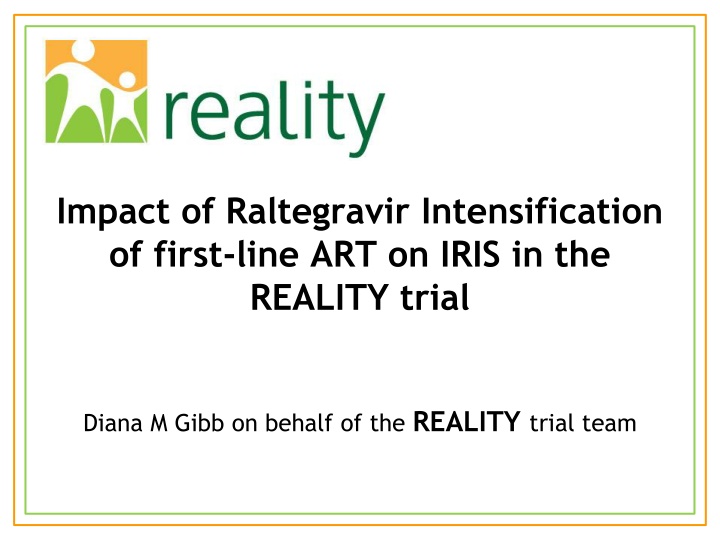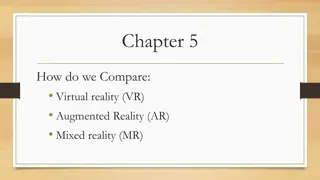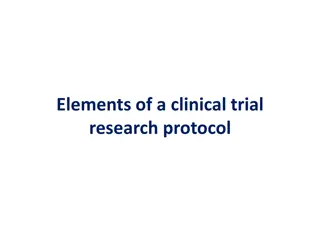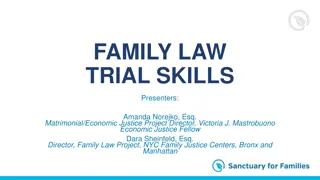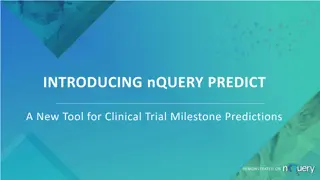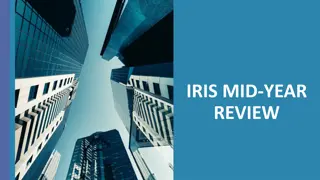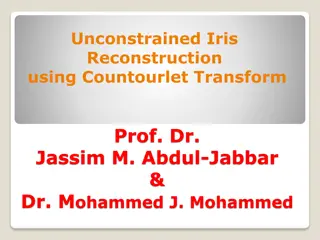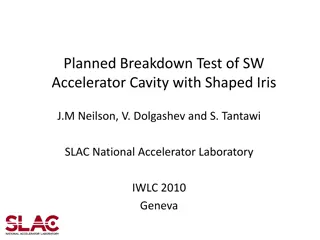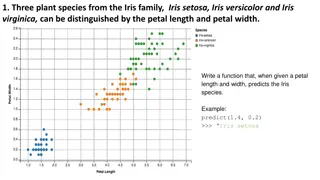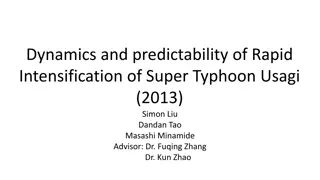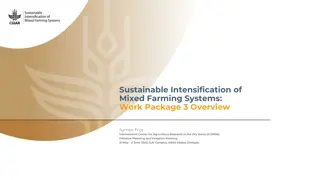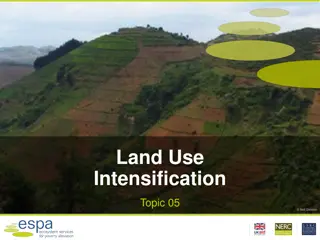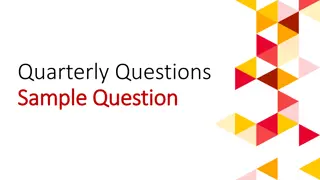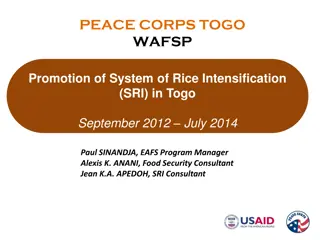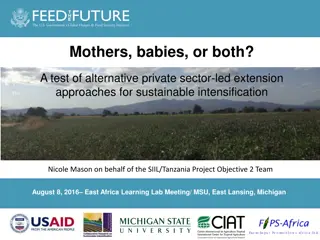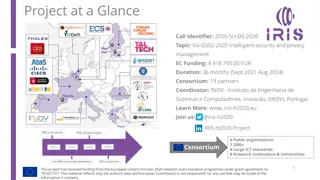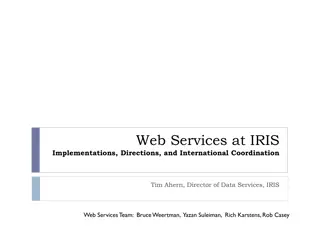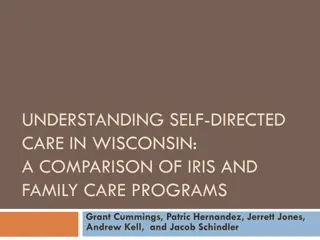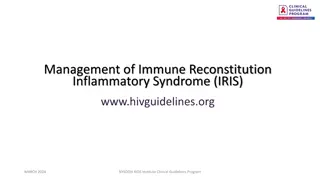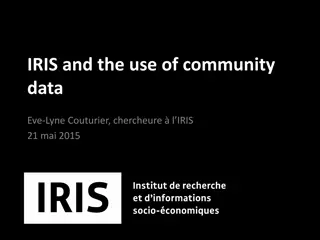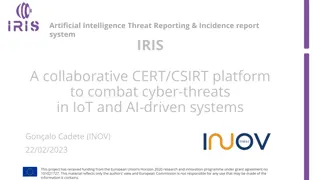Impact of Raltegravir Intensification on IRIS in REALITY Trial
The REALITY trial investigated the impact of Raltegravir intensification on immune reconstitution inflammatory syndrome (IRIS) in individuals starting antiretroviral therapy with low CD4 counts in sub-Saharan Africa. Results showed faster viral load declines with RAL-intensified therapy, but no reduction in mortality or WHO 3/4 events. The study design, trial sites, and methods used in the trial are detailed in the content. The trial aimed to assess the effects of Raltegravir intensification on IRIS rates, providing valuable insights for HIV treatment strategies in resource-limited settings.
Download Presentation

Please find below an Image/Link to download the presentation.
The content on the website is provided AS IS for your information and personal use only. It may not be sold, licensed, or shared on other websites without obtaining consent from the author.If you encounter any issues during the download, it is possible that the publisher has removed the file from their server.
You are allowed to download the files provided on this website for personal or commercial use, subject to the condition that they are used lawfully. All files are the property of their respective owners.
The content on the website is provided AS IS for your information and personal use only. It may not be sold, licensed, or shared on other websites without obtaining consent from the author.
E N D
Presentation Transcript
Impact of Raltegravir Intensification of first-line ART on IRIS in the REALITY trial Diana M Gibb on behalf of the REALITY trial team
Background The Reality trial, in adults/children with CD4<100 cells/ l initiating ART in sub-Saharan Africa, showed: RAL-intensified therapy faster VL declines, but no reduction in mortality or WHO 3/4 events1 Integrase inhibitors (INSTIs) replacing NNRTIs in 1st-line Concern that rapid VL declines may increase rates of immune reconstitution inflammatory syndrome (IRIS) in individuals starting ART with very low CD4 Two observational studies found higher rates of IRIS in those initiating INSTI combinations2, 3 2 1) Kityo et al. IAC 2016. 2) Wijting et al. CROI 2017. 3) Dutertre et al. JAIDS 2017
Design 1805 ART-na ve HIV-infected adults, adolescents & children 5 years with CD4<100 cells/ l 1:1 randomisation Initiate ART with 2NRTI+NNRTI+12 weeks additional raltegravir Initiate ART with 2NRTI+NNRTI alone (standard of care) Follow-up to week 48 Safety bloods at screening, weeks 4 and 48; FBC & CD4 at weeks 0, 12, 24, 36, 48; Viral loads retrospectively at weeks 0, 4, 12, 24, 48 Primary endpoint: 24-week mortality Two other factorial randomisations investigated 12 weeks enhanced prophylaxis (Hakim et al., NEJM 2017) 12 weeks supplementary food (Mallewa et al., CROI 2017) ISRCTN43622374 3
REALITY Trial Sites (ISRCTN43622374) Uganda Fort Portal Gulu Mbale Mbarara Kenya Kilifi Eldoret Zimbabwe Malawi 4
Methods A blinded Endpoint Review Committee (ERC) adjudicated: Serious adverse and grade 3/4 events & WHO stage 3 & 4 events causes of death, and compatibility with IRIS IRIS-compatible = atypical/exaggerated presentation of opportunistic infection/tumour soon after ART initiation VL not available in real time (retrospective, on stored plasma) First CD4 count (and VL) at week 4 Diagnostic testing limited; so published IRIS definitions1, 2 modified ERC relied heavily on description of clinical presentation timing of presentation; evolution in relation to ART initiation radiology/microbiology/histology where available ERC also adjudicated type of IRIS (e.g. TB, cryptococcal) Predictors of time to first fatal/non-fatal IRIS-compatible event Used backwards elimination (exit p=0.05), treating death from other causes as a competing risk 5 1) French et al. AIDS 2004. 2) Meintjes et al. LID 2008
Baseline characteristics n (%) or median (IQR) [range] Characteristic RAL-intensified (N=902) 479 (53%) 36 (30-42) [6-72] 39 (4%) 419 (46%) 38 (16-64) 321 (36%) 246,700 (N=902) 677 (74%) 803 (89%) 703 (78%) Standard (N=903) 482 (53%) 36 (29-42) [5-78] 33 (4%) 435 (48%) 36 (16-61) 335 (37%) 250,000 (N=902) 667 (74%) 816 (90%) 719 (80%) Male Age (years) 5-17 years WHO stage 1 or 2 CD4 (cells/ l) 0-24 cells/ l VL (c/ml) 100,000 c/ml EFV-based ART TDF/FTC NRTI backbone 6
Baseline characteristics n (%) or median (IQR) [range] Characteristic RAL-intensified (N=902) 479 (53%) 36 (30-42) [6-72] 39 (4%) 419 (46%) 38 (16-64) 321 (36%) 246,700 (N=902) 677 (74%) 803 (89%) 703 (78%) Standard (N=903) 482 (53%) 36 (29-42) [5-78] 33 (4%) 435 (48%) 36 (16-61) 335 (37%) 250,000 (N=902) 667 (74%) 816 (90%) 719 (80%) Male Age (years) 5-17 years WHO stage 1 or 2 CD4 (cells/ l) 0-24 cells/ l VL (c/ml) 100,000 c/ml EFV-based ART TDF/FTC NRTI backbone 7
Baseline characteristics n (%) or median (IQR) [range] Characteristic RAL-intensified (N=902) 479 (53%) 36 (30-42) [6-72] 39 (4%) 419 (46%) 38 (16-64) 321 (36%) 246,700 (N=902) 677 (74%) 803 (89%) 703 (78%) Standard (N=903) 482 (53%) 36 (29-42) [5-78] 33 (4%) 435 (48%) 36 (16-61) 335 (37%) 250,000 (N=902) 667 (74%) 816 (90%) 719 (80%) Male Age (years) 5-17 years WHO stage 1 or 2 CD4 (cells/ l) 0-24 cells/ l VL (c/ml) 100,000 c/ml EFV-based ART TDF/FTC NRTI backbone 8
VL<50 copies/ml 100 Percentage with VL<50 copies/ml (95% CI) 80.7% Raltegravir-intensified 76.7% 80 71.9% 79.2% 74.7% Standard 60 41.0% 51.7% 40 Overall p<0.0001 20 13.4% 0 p<0.0001 p<0.0001 p=0.36 p=0.47 0 4 12 24 48 Week since randomisation (ART initiation) 9
Geometric mean VL at baseline and week 4 1 000 000 226,430 217,710 100 000 Geometric mean [95% CI] 10 000 1 000 480 80 100 50 0 4 Week since randomisation (ART initiation) Standard Raltegravir-intensified Mean change in log10 VL at week 4 was 3.4(SE 0.03) in raltegravir-intensified vs -2.7(0.03) in standard (p<0.001) 10
All cause mortality Mortality at 24 weeks: 10.9% RAL vs 10.2% standard-of-care 0.20 w24: HR=1.10 (95% CI 0.82-1.46) Additional RAL 0.15 12.4% 10.9% p=0.53 Died 13.0% 0.10 w48: HR=0.98 (95% CI 0.76-1.28) 10.2% Standard-of-care 0.05 p=0.91 0.00 0 8 16 24 32 40 48 Week since randomisation (ART initiation) Number at risk (deaths) Standard-of-care 903 (57) 830 (23) 801 (10) 789 (7) 776 (10) 760 (8) 669 Additional RAL 902 (65) 825 (20) 801 (11) 786 (6) 775 (3) 766 (5) 657 56 (3.1%) lost to follow-up at 48 weeks No interactions with other randomisations (p>0.7) 11
Incidence of fatal IRIS-compatible events 50 40 Death rate/100 PY (hazard) 30 20 10 0 0 8 16 24 32 40 48 Week since randomisation (ART initiation) Standard Raltegravir-intensified 36 (4.0%) RAL vs 31 (3.4%) standard experienced fatal IRIS (p=0.54), occurring a median 4.4 (IQR 2.6-9.4) weeks after ART initiation 12
Fatal IRIS-compatible events Additional RAL 36 (4.0%) 20 (2.2%) 8 (0.9%) 5 (0.6%) 1 1 1 1 0 1 3 (0.3%) Standard-of-care 31 (3.4%) 21 (2.3%) 5 (0.6%) 4 (0.4%) 2 0 1 0 1 0 1 (0.1%) p All 0.54 1.00 0.42 0.75 TB-IRIS Cryptococcal-IRIS Other of known aetiology Kaposi s sarcoma Viral hepatitis CNS (unknown pathogen) CMV Lung (unknown pathogen) Other Unknown aetiology 13
Incidence of fatal and non-fatal IRIS-compatible events 150 Event rate/100 PY (hazard) 100 50 0 0 8 16 24 32 40 48 Week since randomisation (ART initiation) Standard Raltegravir-intensified Fatal/non-fatal IRIS-compatible events occurred in 89 (9.9%) raltegravir-intensified vs 86 (9.5%) standard (p=0.79) 14
Fatal/non-fatal IRIS-compatible events Additional RAL 89 (9.9%) 53 (5.9%) 15 (1.7%) 17 (1.9%) 8 1 3 2 1 0 0 3 4 (0.4%) Standard-of-care 86 (9.5%) 54 (6.0%) 16 (1.8%) 14 (1.6%) 4 3 1 1 1 2 2 0 2 (0.2%) p All 0.79 1.00 1.00 0.59 TB-IRIS Cryptococcal-IRIS Other of known aetiology Kaposi s sarcoma Viral hepatitis CNS (unknown pathogen) CMV Toxoplasmosis PCP Lung (unknown pathogen) Other Unknown aetiology 15
Independent predictors of fatal/non-fatal IRIS events Subhazard ratio (sHR) [95% CI] 1.08 [0.80-1.45] 0.60 [0.44-0.82] p Raltegravir-intensified vs standard ART Enhanced-prophylaxis vs standard- prophylaxis CD4 count (per 10 cells/ l higher) Age at last birthday (per year older) 29 years 30 years Current TB disease at ART initiation 0.63 0.001 0.87 [0.82-0.93] <0.001 0.03 0.008 0.44 0.01 1.07 [1.02-1.22] 0.99 [0.97-1.01] 1.62 [1.11-2.37] 16
Independent predictors of fatal/non-fatal IRIS events Subhazard ratio (sHR) [95% CI] 1.08 [0.80-1.45] 0.60 [0.44-0.82] p Raltegravir-intensified vs standard ART Enhanced-prophylaxis vs standard- prophylaxis CD4 count (per 10 cells/ l higher) Age at last birthday (per year older) 29 years 30 years Current TB disease at ART initiation 0.63 0.001 0.87 [0.82-0.93] <0.001 0.03 0.008 0.44 0.01 1.07 [1.02-1.22] 0.99 [0.97-1.01] 1.62 [1.11-2.37] No additional effect of: log10 VL (p=0.40) current cryptococcus at ART initiation (p=0.22), current steroid treatment at ART initiation (p=0.41) gender (p=0.24) 17
Incidence of fatal/non-fatal IRIS by prophylaxis randomisation Standard-prophylaxis Cotrimoxazole Enhanced-prophylaxis Cotrimoxazole + - 12 weeks isoniazid/B6 - 12 weeks fluconazole - 5 days azithromycin - single-dose albendazole Fatal/non-fatal IRIS-compatible events occurred in 67 (7.4%) enhanced-prophylaxis vs 108 (12.0%) standard (p=0.001) 18
Incidence of fatal/non-fatal IRIS by prophylaxis randomisation Poster 490 Standard-prophylaxis Cotrimoxazole *CTX/INH/B6 scored FDC Enhanced-prophylaxis Cotrimoxazole + - 12 weeks isoniazid/B6 - 12 weeks fluconazole - 5 days azithromycin - single-dose albendazole Fatal/non-fatal IRIS-compatible events occurred in 67 (7.4%) enhanced-prophylaxis vs 108 (12.0%) standard (p=0.001) 19
Conclusions Our randomised trial, in severely immunocompromised patients, found no evidence supporting higher rates of IRIS associated with faster VL decline in ART with raltegravir Rates of IRIS were lower than some studies1 Some IRIS potentially misclassified due to limited information and grade 1/2 events not reviewed Likely included most clinically important events & ERC blind Close EARLY contact with patients (even if asymptomatic), ensuring they seek urgent medical care if new symptoms Current move to first-line integrase inhibitor (INSTI)-based ART across many lower/middle-income countries Similar rapid VL reductions with all INSTIs2 Results can likely be extrapolated to INSTIs other than raltegravir, including dolutegravir 20 1) M ller et al. LID 2010. 2) Raffi et al. Lancet 2013
Acknowledgments We thank all the patients and staff from all the centres participating in the REALITY trial. Participating Centres: Joint Clinical Research Centre (JCRC), Kampala, Uganda (coordinating centre for Uganda): P Mugyenyi, C Kityo, V Musiime, P Wavamunno, E Nambi, P Ocitti, M Ndigendawani. JCRC, Fort Portal, Uganda: S Kabahenda, M Kemigisa, J Acen, D Olebo, G Mpamize, A Amone, D Okweny, A Mbonye, F Nambaziira, A Rweyora, M Kangah and V Kabaswahili . JCRC, Gulu,Uganda: J Abach, G Abongomera, J Omongin, I Aciro, A Philliam, B Arach, E Ocung, G Amone, P Miles, C Adong, C Tumsuiime, P Kidega, B Otto, F Apio. JCRC, Mbale, Uganda: K Baleeta, A Mukuye, M Abwola, F Ssennono, D Baliruno, S Tuhirwe, R Namisi, F Kigongo, D Kikyonkyo, F Mushahara, D Okweny, J Tusiime, A Musiime, A Nankya, D Atwongyeire, S Sirikye, S Mula, N Noowe. JCRC, Mbarara, Uganda: A Lugemwa, M Kasozi, S Mwebe, L Atwine, T Senkindu, T Natuhurira, C Katemba, E Ninsiima, M Acaku J Kyomuhangi, R Ankunda, D Tukwasibwe, L Ayesiga. University of Zimbabwe Clinical Research Centre, Harare, Zimbabwe: J Hakim, K Nathoo, M Bwakura-Dangarembizi, A Reid, E Chidziva, T Mhute, GC Tinago, J Bhiri, S Mudzingwa, M Phiri, J Steamer, R Nhema, C Warambwa, G Musoro, S Mutsai, B Nemasango, C Moyo, S Chitongo, K Rashirai, S Vhembo, B Mlambo, S Nkomani, B Ndemera, M Willard, C Berejena, Y Musodza, P Matiza, B Mudenge, V Guti. KEMRI Wellcome Trust Research Programme, Kilifi, Kenya: A Etyang, C Agutu, J Berkley, K Maitland, P Njuguna, S Mwaringa, T Etyang, K Awuondo, S Wale, J Shangala, J Kithunga, S Mwarumba, S Said Maitha, R Mutai, M Lozi Lewa, G Mwambingu, A Mwanzu, C Kalama, H Latham, J Shikuku, A Fondo, A Njogu, C Khadenge, B Mwakisha. Moi University Clinical Research Centre, Eldoret, Kenya: A Siika, K Wools-Kaloustian, W Nyandiko, P Cheruiyot, A Sudoi, S Wachira, B Meli, M Karoney, A Nzioka, M Tanui, M Mokaya, W Ekiru, C Mboya, D Mwimali, C Mengich, J Choge, W Injera, K Njenga, S Cherutich, M Anyango Orido,G Omondi Lwande, P Rutto, A Mudogo, I Kutto, A Shali, L Jaika, H Jerotich, M Pierre. Department of Medicine and MLW Clinical Research Programme, College of Medicine, Blantyre, Malawi: J Mallewa, S Kaunda, J Van Oosterhout, B O'Hare, R Heydermann, C Gonzalez, N Dzabala, C Kelly, B Denis, G Selemani, L Nyondo Mipando, E Chirwa, P Banda, L Mvula, H Msuku, M Ziwoya, Y Manda, S Nicholas, C Masesa , T Mwalukomo, L Makhaza, I Sheha, J Bwanali, M Limbuni. Trial Coordination and Oversight: MRC Clinical Trials Unit at UCL, London, UK: D Gibb, M Thomason, AS Walker, S Pett, A Szubert, A Griffiths, H Wilkes, C Rajapakse, M Spyer, A Prendergast, N Klein. Data Management Systems: M Rauchenberger, N Van Looy, E Little, K Fairbrother. Trial Steering Committee: I Weller (Chair), E Malianga, C Mwansambo, F Miiro, P Elyanu, E Bukusi, E Katabira, O Mugurungi, D Gibb, J Hakim, A Etyang, P Mugyenyi, J Mallewa. Data Monitoring Committee: T Peto (Chair), P Musoke, J Matenga, S Phiri. Endpoint Review Committee (independent members): H Lyall (Co-Chair), V Johnston (Co-Chair), F Fitzgerald, F Post, F Ssali, A Prendergast, A Turkova, A Bamford, A Arenas-Pinto. Social Science Group: F Cowan, J Seeley, S Bernays, R Kawuma, Z Mupambireyi. Independent REALITY Trial Monitors: F Kyomuhendo, S Nakalanzi, J Peshu, S Ndaa, J Chabuka, N Mkandawire, L Matandika, C Kapuya
Acknowledgments We thank all the patients and staff from all the centres participating in the REALITY trial. Participating Centres: Joint Clinical Research Centre (JCRC), Kampala, Uganda (coordinating centre for Uganda): P Mugyenyi, C Kityo, V Musiime, P Wavamunno, E Nambi, P Ocitti, M Ndigendawani. JCRC, Fort Portal, Uganda: S Kabahenda, M Kemigisa, J Acen, D Olebo, G Mpamize, A Amone, D Okweny, A Mbonye, F Nambaziira, A Rweyora, M Kangah and V Kabaswahili . JCRC, Gulu,Uganda: J Abach, G Abongomera, J Omongin, I Aciro, A Philliam, B Arach, E Ocung, G Amone, P Miles, C Adong, C Tumsuiime, P Kidega, B Otto, F Apio. JCRC, Mbale, Uganda: K Baleeta, A Mukuye, M Abwola, F Ssennono, D Baliruno, S Tuhirwe, R Namisi, F Kigongo, D Kikyonkyo, F Mushahara, D Okweny, J Tusiime, A Musiime, A Nankya, D Atwongyeire, S Sirikye, S Mula, N Noowe. JCRC, Mbarara, Uganda: A Lugemwa, M Kasozi, S Mwebe, L Atwine, T Senkindu, T Natuhurira, C Katemba, E Ninsiima, M Acaku J Kyomuhangi, R Ankunda, D Tukwasibwe, L Ayesiga. University of Zimbabwe Clinical Research Centre, Harare, Zimbabwe: J Hakim, K Nathoo, M Bwakura-Dangarembizi, A Reid, E Chidziva, T Mhute, GC Tinago, J Bhiri, S Mudzingwa, M Phiri, J Steamer, R Nhema, C Warambwa, G Musoro, S Mutsai, B Nemasango, C Moyo, S Chitongo, K Rashirai, S Vhembo, B Mlambo, S Nkomani, B Ndemera, M Willard, C Berejena, Y Musodza, P Matiza, B Mudenge, V Guti. KEMRI Wellcome Trust Research Programme, Kilifi, Kenya: A Etyang, C Agutu, J Berkley, K Maitland, P Njuguna, S Mwaringa, T Etyang, K Awuondo, S Wale, J Shangala, J Kithunga, S Mwarumba, S Said Maitha, R Mutai, M Lozi Lewa, G Mwambingu, A Mwanzu, C Kalama, H Latham, J Shikuku, A Fondo, A Njogu, C Khadenge, B Mwakisha. Moi University Clinical Research Centre, Eldoret, Kenya: A Siika, K Wools-Kaloustian, W Nyandiko, P Cheruiyot, A Sudoi, S Wachira, B Meli, M Karoney, A Nzioka, M Tanui, M Mokaya, W Ekiru, C Mboya, D Mwimali, C Mengich, J Choge, W Injera, K Njenga, S Cherutich, M Anyango Orido,G Omondi Lwande, P Rutto, A Mudogo, I Kutto, A Shali, L Jaika, H Jerotich, M Pierre. Department of Medicine and MLW Clinical Research Programme, College of Medicine, Blantyre, Malawi: J Mallewa, S Kaunda, J Van Oosterhout, B O'Hare, R Heydermann, C Gonzalez, N Dzabala, C Kelly, B Denis, G Selemani, L Nyondo Mipando, E Chirwa, P Banda, L Mvula, H Msuku, M Ziwoya, Y Manda, S Nicholas, C Masesa , T Mwalukomo, L Makhaza, I Sheha, J Bwanali, M Limbuni. Trial Coordination and Oversight: MRC Clinical Trials Unit at UCL, London, UK: D Gibb, M Thomason, AS Walker, S Pett, A Szubert, A Griffiths, H Wilkes, C Rajapakse, M Spyer, A Prendergast, N Klein. Data Management Systems: M Rauchenberger, N Van Looy, E Little, K Fairbrother. Trial Steering Committee: I Weller (Chair), E Malianga, C Mwansambo, F Miiro, P Elyanu, E Bukusi, E Katabira, O Mugurungi, D Gibb, J Hakim, A Etyang, P Mugyenyi, J Mallewa. Data Monitoring Committee: T Peto (Chair), P Musoke, J Matenga, S Phiri. Endpoint Review Committee (independent members): H Lyall (Co-Chair), V Johnston (Co-Chair), F Fitzgerald, F Post, F Ssali, A Prendergast, A Turkova, A Bamford, A Arenas-Pinto. Social Science Group: F Cowan, J Seeley, S Bernays, R Kawuma, Z Mupambireyi. Independent REALITY Trial Monitors: F Kyomuhendo, S Nakalanzi, J Peshu, S Ndaa, J Chabuka, N Mkandawire, L Matandika, C Kapuya Funders: REALITY was funded by Joint Global Health Trials Scheme of the UK Department for International Development (DFID), the Wellcome Trust and Medical Research Council (MRC). Additional funding support is provided by the PENTA foundation. Merck Sharp & Dohme,Gilead Sciences, Cipla Ltd, ViiV Healthcare/GlaxoSmithKline donated drugs for REALITY and Valid International supplied Ready-to-Use-Supplementary-Food (RUSF).
